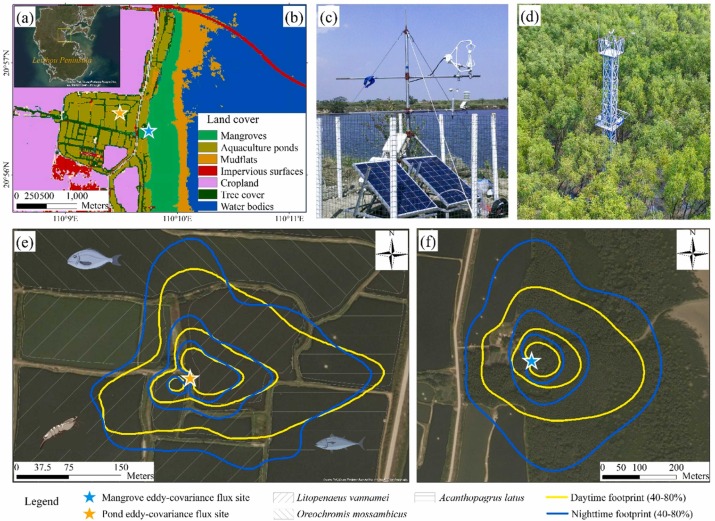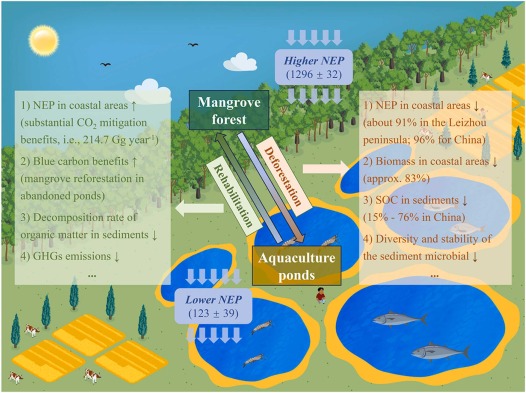Mangroves, as an important part of coastal wetlands, play an important role in wind and wave resistance, protecting embankments and maintaining biodiversity, as well as sequestering atmospheric carbon dioxide (CO2) and mitigating global climate change. However, over the past few decades, with the construction of large-scale seawater aquaculture ponds for the development of aquaculture, the coverage of mangrove wetlands and seedling regeneration areas in southern China have been seriously reduced. To address this issue, the national and local governments have launched action plans such as converting ponds to back to mangroves and rehabilitating mangroves, in order to increase the area of mangroves, enhance carbon sequestration functions, and protect marine biodiversity. However, due to the lack of synchronized monitoring of CO2 flux in mangroves and coastal ecosystems in conflict with them, such as aquaculture ponds, it is difficult to quantitatively evaluate the changes in carbon sink effects of deforestation for pond construction or converting ponds back to mangroves. There is also a lack of systematic research on how these human activities affect carbon exchange in mangrove wetland ecosystems.
To solve the above problem, Professor Lin Guanghui’s Research Group of Tsinghua University DESS deployed two sets of vorticity covariance systems in mangroves and neighboring aquaculture ponds in the Leizhou Peninsula, China, synchronously measured the CO2 fluxes between the atmosphere and the ecosystems for multiple consecutive years (Fig. 1), and compared the patterns and driving mechanisms of CO2 fluxes in mangrove and aquaculture pond ecosystems at different time scales (diurnal, daily, seasonal, and annual). This study has provided direct data support and research foundation for the further implementation of the project of converting ponds back to mangroves in the region.

Fig. 1. Geographical location and land use classification of the study area in the Leizhou Peninsula, China, along with two eddy-covariance flux sites and their flux measurement footprints during daytime (yellow lines) and nighttime (blue lines). (a) Locations of the study area in the Leizhou Peninsula, China. (b) Land use types of the study area. (c and d) Views of the eddy-covariance flux sites in aquaculture ponds and mangroves. The footprint contour lines for (e) pond and (f) mangrove sites are shown in increments of 20% from 40% (inner circle) to 80% (outer circle). The areas of the 45 degree, 90 degree and 135 degree clockwise lines represent Litopenaeus vannamei, Acanthopagrus latus, and Oreochromis mossambicus, respectively.
The research results show that both the mangroves and aquaculture ponds were CO2 sinks at the annual scale, with net of, with annual average ecosystem production (NEP) values of 123 ± 39 and 1296 ± 32 g C m-2 year-1, respectively. The NEP of subtropical mangrove wetlands is far higher than that of pond wetlands (about ten times higher), while the aquaculture ponds had obvious seasonal fluctuations in NEP and became carbon sources in certain seasons. In addition, our study quantitatively evaluated the potential impact of conversions between mangroves and aquaculture ponds on the NEP of subtropical mangrove wetlands (Fig. 2). For instance, mangrove deforestation for pond construction would directly reduce NEP along the coasts of the Leizhou Peninsula by about 91%, while ceasing the uses of all aquaculture ponds for mangrove rehabilitation along the coasts of the Leizhou Peninsula could offer the potential for significant carbon sequestration benefits (an additional absorption of 214.7 Gg-CO2 year−1). This study has provided theoretical foundation and scientific basis for further mangrove rehabilitation and management, and improving the carbon sequestration of coastal wetlands in southern China.

Fig. 2 Schematic diagram of the potential impact of mangrove-pond conversions (i.e. deforestation and rehabilitation) on the coastal wetlands.
The related research results have been published online in Agriculture, Ecosystems & Environment as a paper titled “CO2 fluxes contrast between aquaculture ponds and mangroves and its implications for coastal wetland rehabilitation in Leizhou Peninsula, China”. DESS doctoral graduate Gou Ruikun from Tsinghua University is the first author of the paper, and DESS Professor Lin Guanghui is the corresponding author. Co-authors include Associate Professor Feng Jianxiang from Sun Yat-sen University, Associate Professor Zhou Haichao and Dr. Lang Tao from Shenzhen University, Dr. Zhao Jiayu from Guangdong Ocean University, Dr. Mo Lidong from ETH Zurich, and DESS doctoral candidate Song Shanshan. This study was financially supported in part by the grants from the National Key Research and Development Program of China (2019YFA0606604), and also the Shenzhen City’s University Stable Support Program (WDZC2020819173345002).
Full-text link:
https://www.sciencedirect.com/science/article/pii/S0167880924000860
Written by Gou Ruikun and Lin Guanghui